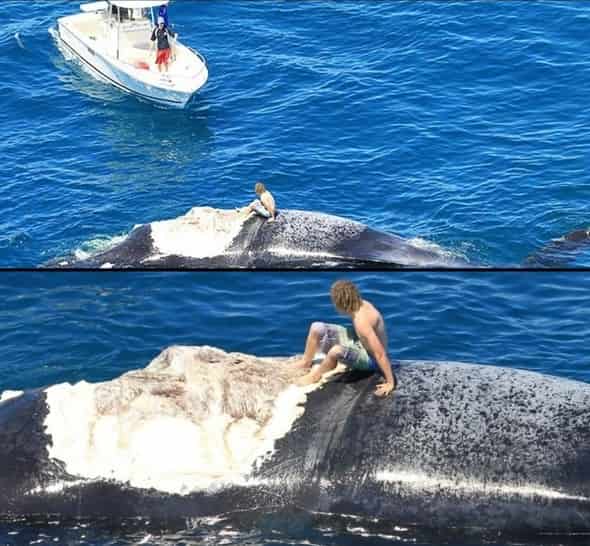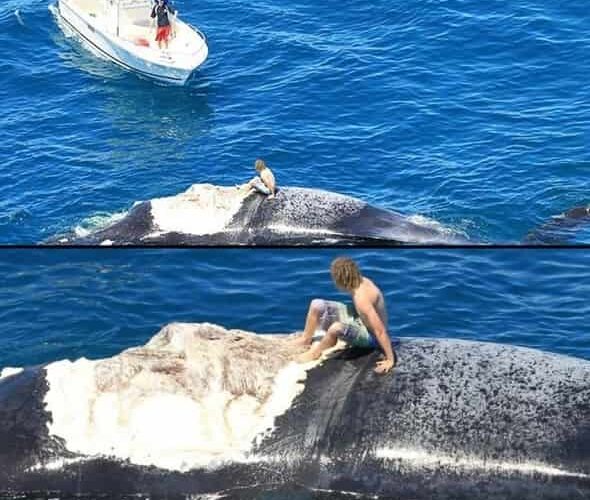Harrison Williams: The Man Who Jumped Onto a Dead Whale Being Eaten By Sharks
In the world of viral stories and unbelievab le stunts, some acts leave an indelible mark for their sheer audacity and bewildering nature. One such story that captured global attention is that of Harrison Williams, the Australian man who jumped onto a dead whale surrounded by sharks in 2014.
le stunts, some acts leave an indelible mark for their sheer audacity and bewildering nature. One such story that captured global attention is that of Harrison Williams, the Australian man who jumped onto a dead whale surrounded by sharks in 2014.
This bold, bizarre, and adrenaline-charged event shocked the world and continues to be discussed as a unique example of daring stunts, environmental risks, and a viral phenomenon that escalated into a cautionary tale. Let’s explore the story of Harrison Williams, the dead whale, and the dangerous creatures lurking below.
The Story Behind the Stunt
In November 2014, Harrison Williams, a 26-year-old from Perth, Australia, was boating with friends off the coast of Western Australia near the city of Perth when he encountered something unusual – a floating carcass of a humpback whale. But what made this sight even more extraordinary was the congregation of tiger sharks and great whites circling the dead whale.
For most people, the sight of a massive dead whale, coupled with numerous predators, would be enough to send them in the opposite direction. For Harrison Williams, however, it became an irresistible challenge. Ignoring the potential dangers, he made the split-second decision to leap into the water, swim toward the carcass, and climb atop the dead whale’s body.
The Motivation: Why Did Harrison Williams Jump?
People who heard about Williams’ leap were perplexed and concerned. The natural question that came to mind was, “Why would anyone jump onto a dead whale surrounded by sharks?” When interviewed, Williams stated that his original intention was to check if the whale was alive and in need of assistance. When he realized it was dead, however, his focus shifted toward simply wanting to accomplish something memorable and attention-grabbing.
Many news outlets called it a “stupid stunt,” while some friends of Williams joked that it would make an “epic selfie.” Yet, for Williams, it was less about seeking fame or trying to challenge nature and more of a spontaneous decision. He admitted he hadn’t fully considered the consequences or the potential danger of his actions.
The Danger: Why Swimming Near a Dead Whale is Extremely Risky
Dead whales attract a host of scavengers in the ocean, including the very sharks that encircled this carcass. When a whale dies, it begins to decompose, releasing oils and bodily fluids into the surrounding waters. This process, known as “whale fall,” creates a hotspot for marine life looking to feed on the nutrients that the dead body provides.
Harrison Williams’s leap onto the dead whale put him directly into a zone teeming with shark activity. Tiger sharks and great white sharks, two of the most dangerous shark species, are often drawn to such sites. Approaching them or interacting with their food source can trigger aggression, making it a dangerous environment for any human.
Marine experts were quick to condemn Williams’ actions as reckless, pointing out that he had put himself at risk for what could have been a fatal shark attack. While Williams emerged unscathed, this stunt served as a reminder of the unpredictable and sometimes deadly behavior of marine predators when competing over a food source.
The Aftermath and Public Reaction
As soon as images and video footage of Williams standing atop the whale surfaced, the story went viral. Media outlets worldwide reported on the bizarre incident, describing Williams’s actions with a mix of astonishment and criticism. Some individuals praised him for his bravery, while others called him out for his recklessness, labeling the stunt as a “foolish” move that could have had deadly consequences.
Marine conservationists were particularly vocal, pointing out that this type of behavior promotes a disregard for wildlife and marine safety protocols. Public officials and environmental experts expressed concern that Williams’ actions might inspire similar stunts, putting more people at risk and disturbing marine ecosystems.
Legal and Environmental Implications
Though Williams did not face formal charges for his actions, the incident prompted discussions around legal protections for marine wildlife and the potential repercussions for anyone attempting similar stunts in the future. Approaching a dead whale can be considered tampering with a natural scene, which in some regions is legally protected. In this instance, Williams’s actions did not breach any specific Australian laws, but the public backlash was intense.
Moreover, the event sparked a discussion on ethical conduct and respect for nature. Environmental groups argued that climbing onto a dead animal showed a lack of reverence for marine life, regardless of the animal’s condition. This incident served as an opportunity for education on marine safety and respect for ocean ecosystems.
Social Media Fame and the Age of Viral Stunts
Harrison Williams’s stunt occurred in an era when social media stunts and viral fame were increasingly common. Although he didn’t jump onto the whale specifically to gain social media recognition, the incident showcases how quickly an unusual act can gain global attention. Within days, images and videos of Williams spread across the internet, reaching news outlets in almost every continent.
The incident raised questions about the lengths people will go to for momentary fame or simply to stand out. Experts suggested that such stunts can have a “copycat” effect, where others attempt similar feats to gain social media attention, sometimes with tragic results. The desire to capture “the perfect shot” or “the best story” has led many into risky situations, with Williams’ jump onto the dead whale being a prime example.
Lessons Learned from Harrison Williams’ Experience
The story of Harrison Williams serves as a valuable lesson on several fronts.
– Respect for Nature: The ocean is a complex ecosystem with unique dangers, and disturbing natural occurrences like a whale carcass surrounded by predators can have ecological consequences.
– Consideration of Risks: While bold actions can make great stories, they also come with significant risks. Taking a moment to consider potential dangers might save lives in similar situations.
– Impact of Social Media: Social media’s role in magnifying stunts and odd behavior continues to grow, encouraging people to seek risky actions for the sake of “likes” and “shares.”
– Public Education on Marine Safety: Incidents like this underscore the importance of educating the public on marine safety and the dangers posed by wildlife encounters, particularly in open water settings.
A Tale to Remember
The story of Harrison Williams, the man who jumped onto a dead whale surrounded by sharks, is not only unforgettable but also carries essential reminders about respecting nature, assessing risks, and the power of social media in amplifying unusual acts. Although Williams walked away unharmed, his story remains a symbol of audacious stunts that test the boundaries between thrill-seeking and recklessness.
As we continue to hear of similar stunts and encounters with wildlife, the tale of Harrison Williams stands as a reminder of the thin line between adventurous curiosity and dangerous folly. For future thrill-seekers, this story is a powerful example of why respecting the natural world – and the dangers it presents – should always come first.
FAQs on Harrison Williams and the Dead Whale Incident
1. Who is Harrison Williams?
Harrison Williams is an Australian man from Perth who gained international attention in 2014 when he jumped onto a floating dead whale carcass surrounded by sharks off the coast of Western Australia.
2. Why did Harrison Williams jump onto the dead whale?
Initially, Williams claimed he thought the whale might be alive and needing help. Once he realized it was dead, he decided to make the jump as a bold, memorable act, even though he didn’t fully consider the potential dangers involved.
3. Were there sharks around the whale when Williams jumped onto it?
Yes, there were multiple sharks around the whale, including tiger sharks and great whites, which were drawn by the scent and nutrients released by the decomposing whale. These sharks posed a significant risk to anyone near the carcass.
4. What was the public reaction to Williams’ actions?
The public had mixed reactions. Some praised his bravery, while many others condemned his actions as reckless and dangerous. Environmentalists and marine conservationists especially criticized his behavior, stating that it showed a lack of respect for marine life and ocean safety.
5. Did Harrison Williams face any legal consequences?
No, Harrison Williams did not face legal consequences. However, his actions sparked discussions about marine safety and ethical conduct around wildlife, with some calling for stricter rules to protect natural occurrences in marine ecosystems.
6. Why are dead whales in the ocean dangerous to approach?
Dead whales release oils and other nutrients that attract predators, especially sharks. This phenomenon, called “whale fall,” creates a feeding ground for sharks, which can become aggressive when competing over food. Approaching a dead whale can put humans at serious risk of a shark attack.
7. Did Harrison Williams intend for this stunt to go viral?
Williams claimed he didn’t intend for the stunt to go viral. However, photos and videos of him on the whale quickly spread across social media and news outlets, gaining worldwide attention.
8. What were the lessons learned from this incident?
The incident highlighted the importance of respecting marine life and being aware of the dangers posed by wildlife interactions. It also serves as a reminder of how social media fame can influence risky behavior, especially when people attempt to capture unusual or dramatic moments.
9. How has this incident impacted public perception of marine safety?
This incident underscored the need for public education on marine safety, especially when it comes to dangerous wildlife encounters. Many believe that educating people on the risks of marine life can help prevent similar risky behaviors in the future.
10. What is “whale fall”?
“Whale fall” refers to the process by which a whale carcass sinks to the ocean floor, creating a unique ecosystem as it decomposes. The dead body attracts various marine species, including scavengers and predators like sharks, who feed on the nutrients released.
11. Is jumping onto a dead whale illegal?
While there are no specific laws about climbing onto dead whales in many regions, such actions can potentially disturb wildlife and violate protected areas. It’s often discouraged for safety and environmental reasons, and marine authorities may take action if they believe it disturbs local ecosystems.
12. How should people handle encounters with dead marine animals in the ocean?
People are advised to avoid dead marine animals, especially if there are sharks or other predators nearby. Instead of interacting with them, it’s safer to report such sightings to local authorities, who can assess and manage the situation appropriately.
13. Did this incident inspire other similar stunts?
While there’s no clear evidence of copycat incidents, the viral nature of this story raised concerns among experts about the potential influence on others to attempt similar dangerous actions for social media attention.
14. What should others take away from Harrison Williams’ experience?
The key takeaways are the importance of respecting marine life, understanding the risks associated with ocean wildlife, and thinking carefully before attempting actions that could endanger oneself or others. Additionally, the power of social media should not drive people to perform stunts that put them in harm’s way.

